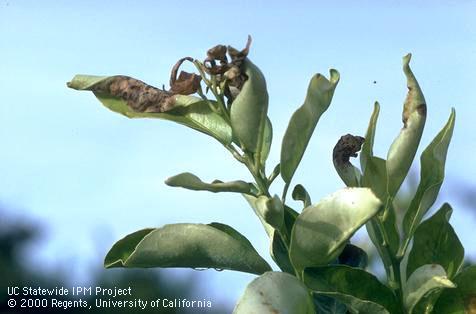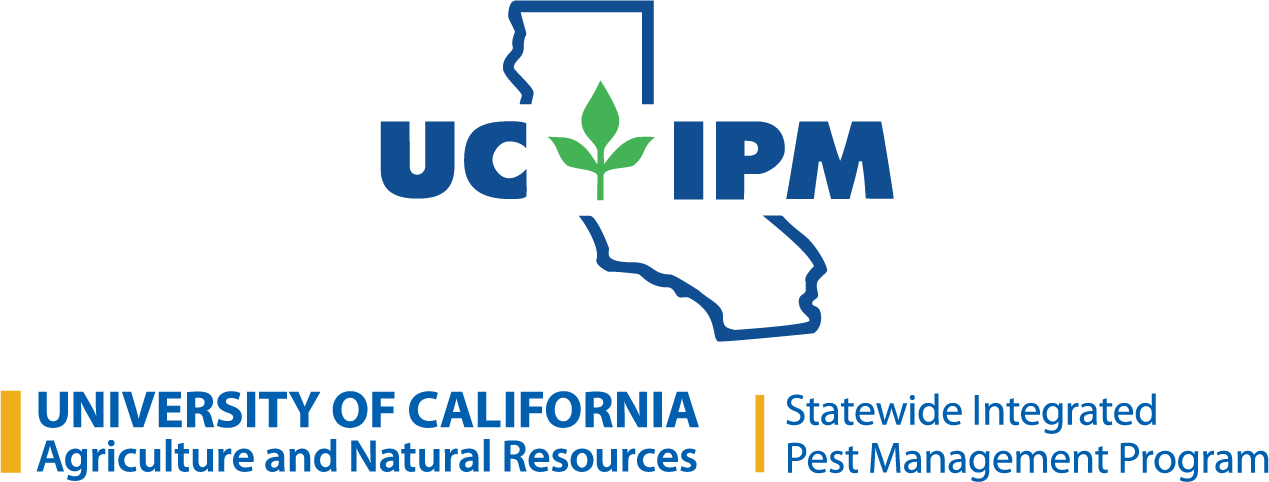Because it is a subtropical plant, citrus is particularly susceptible to cold damage (freezing and frost).
Identification
Cold damaged leaves and twigs become water soaked, withered, and dark brown to black. Frost damage mainly appears on outer and upper shoot terminals and on the outside of fruit exposed to radiative cooling (frost). Cold also can cause shoot dieback and bark that cankers and peels off.
Because cold ruptures oil cells in the fruit rind, the result is oil leakage damage to the rind surface. This damage can be visible as watery, brownish spots or pits called ice marks. Fruit pulp underneath the ice marks ultimately dries and the ice marks provide entry sites for decay microorganisms. Cold-damaged fruit may drop suddenly from the tree, but severe fruit damage can occur without fruit drop or obvious rind markings. This fruit is unpalatable because the flesh is dehydrated. Fruit damage may not be apparent until fruit is cut open.
Symptoms resembling those of freezing and frost injury are also caused by anthracnose fungus and certain other leaf and shoot diseases, gas or mechanical injury to roots, phytotoxicity from herbicides or other chemicals, and water deficit.

Disorder Development
Frost and freezing produce the same damage but occur under different conditions, and some of their management strategies differ. Freezing occurs when air temperatures are 32°F or colder. Frost occurs when air is warmer than 32°F but plant tissues drop to 32°F or below because plants radiate (lose) heat into the atmosphere, especially during cool, clear nights.
The time of year, minimum temperature, duration of cold, and the rate at which temperatures drop influence the severity of damage. Damage severity is also influenced by plant characteristics, such as age, hydration, part affected, and whether the plant has acclimated to cooler weather. Plants that are gradually exposed to increasingly cool weather during the fall become acclimated (hardened) and tolerate more cold than during spring and summer.
Susceptibility to cold also varies with the cultivars of the rootstock and scion. For example, Eureka lemon and grapefruit are among the most cold-sensitive scions, whereas mandarin, Meyer lemon, and sweet orange are more cold hardy.
Damage
Fruit, immature or young shoots, and young trees are the most susceptible to cold damage. Cold temperatures can also injure the limbs and trunk. Damage to major woody parts generally occurs only on young trees, which can be killed. Limb and trunk damage to older citrus trees is less common and may not be apparent until long after the cold weather when cankers develop in bark and wood or bark peels off.

Solutions
Where cold weather is common, if planting citrus chose the more cold-hardy cultivars listed above. Practices such as avoiding pruning or fertilizing during late summer, avoiding oil sprays in the fall, and providing cold protection during critical cold-injury times can reduce the impact of frost and sometimes freezing. When frost or freezing are expected, irrigate dry topsoil at least 3 days before the cold weather to increase the soil's ability to absorb heat that soil then radiates up into trees.
When frost is expected, cover citrus trees overnight with cloth or similar material other than plastic to reduce heat loss to the atmosphere. Leave covers open at their bottom so heat from soil can help warm plants. Remove covers during the day.
During freezing, covering plants is of little help unless a heat source is provided. Placing incandescent lights designed for outdoor use in the canopy may generate enough heat to prevent plants from freezing if plants are also covered. Be sure not to create hazards of electrical shock or fire.
If trees are damaged by a frost or freeze, do not remove dead branches or leaves until late spring or summer. Prune out dead material only after new growth develops. Pruning too early may remove live branches and increase the risk of more damage. An exception is limbs or trunks that are hazards and may fall; these should be promptly removed.
References
Adapted from Integrated Pest Management for Citrus and Pests of Landscape Trees and Shrubs: An Integrated Pest Management Guide, University of California Statewide Integrated Pest Management Program (UC IPM).
